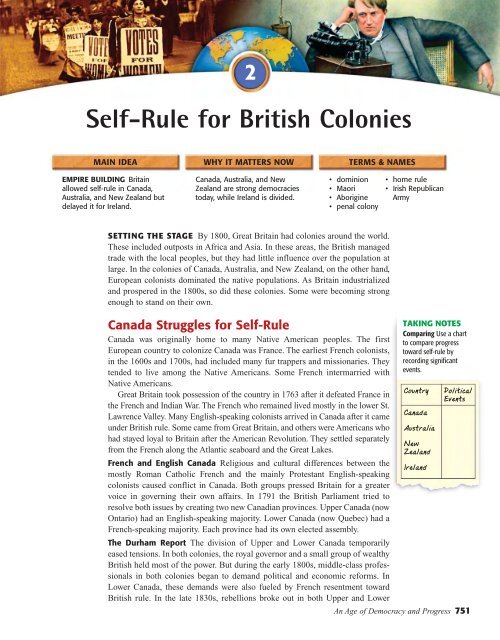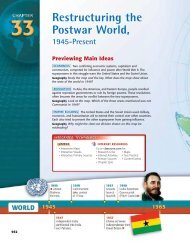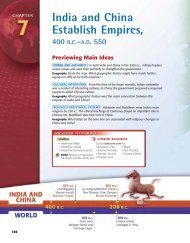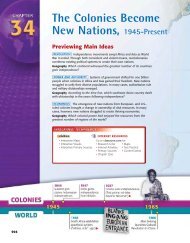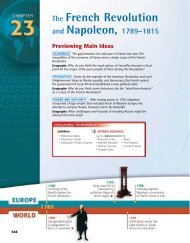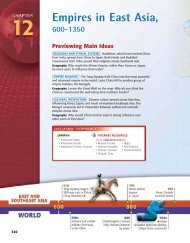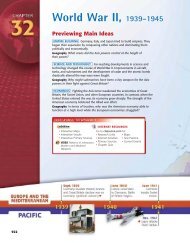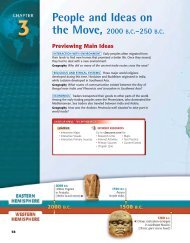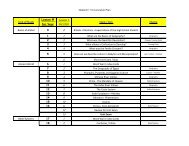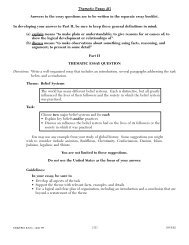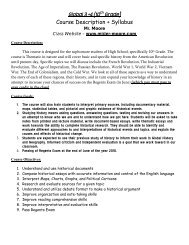The Industrial Revolution, 1700– 1900 Previewing Main Ideas
The Industrial Revolution, 1700– 1900 Previewing Main Ideas
The Industrial Revolution, 1700– 1900 Previewing Main Ideas
Create successful ePaper yourself
Turn your PDF publications into a flip-book with our unique Google optimized e-Paper software.
MAIN IDEA WHY IT MATTERS NOW TERMS & NAMES<br />
EMPIRE BUILDING Britain<br />
allowed self-rule in Canada,<br />
Australia, and New Zealand but<br />
delayed it for Ireland.<br />
2<br />
Self-Rule for British Colonies<br />
Canada, Australia, and New<br />
Zealand are strong democracies<br />
today, while Ireland is divided.<br />
• dominion<br />
• Maori<br />
• Aborigine<br />
• penal colony<br />
SETTING THE STAGE By 1800, Great Britain had colonies around the world.<br />
<strong>The</strong>se included outposts in Africa and Asia. In these areas, the British managed<br />
trade with the local peoples, but they had little influence over the population at<br />
large. In the colonies of Canada, Australia, and New Zealand, on the other hand,<br />
European colonists dominated the native populations. As Britain industrialized<br />
and prospered in the 1800s, so did these colonies. Some were becoming strong<br />
enough to stand on their own.<br />
Canada Struggles for Self-Rule<br />
Canada was originally home to many Native American peoples. <strong>The</strong> first<br />
European country to colonize Canada was France. <strong>The</strong> earliest French colonists,<br />
in the 1600s and 1700s, had included many fur trappers and missionaries. <strong>The</strong>y<br />
tended to live among the Native Americans. Some French intermarried with<br />
Native Americans.<br />
Great Britain took possession of the country in 1763 after it defeated France in<br />
the French and Indian War. <strong>The</strong> French who remained lived mostly in the lower St.<br />
Lawrence Valley. Many English-speaking colonists arrived in Canada after it came<br />
under British rule. Some came from Great Britain, and others were Americans who<br />
had stayed loyal to Britain after the American <strong>Revolution</strong>. <strong>The</strong>y settled separately<br />
from the French along the Atlantic seaboard and the Great Lakes.<br />
French and English Canada Religious and cultural differences between the<br />
mostly Roman Catholic French and the mainly Protestant English-speaking<br />
colonists caused conflict in Canada. Both groups pressed Britain for a greater<br />
voice in governing their own affairs. In 1791 the British Parliament tried to<br />
resolve both issues by creating two new Canadian provinces. Upper Canada (now<br />
Ontario) had an English-speaking majority. Lower Canada (now Quebec) had a<br />
French-speaking majority. Each province had its own elected assembly.<br />
<strong>The</strong> Durham Report <strong>The</strong> division of Upper and Lower Canada temporarily<br />
eased tensions. In both colonies, the royal governor and a small group of wealthy<br />
British held most of the power. But during the early 1800s, middle-class professionals<br />
in both colonies began to demand political and economic reforms. In<br />
Lower Canada, these demands were also fueled by French resentment toward<br />
British rule. In the late 1830s, rebellions broke out in both Upper and Lower<br />
• home rule<br />
• Irish Republican<br />
Army<br />
TAKING NOTES<br />
Comparing Use a chart<br />
to compare progress<br />
toward self-rule by<br />
recording significant<br />
events.<br />
Country Political<br />
Events<br />
Canada<br />
Australia<br />
New<br />
Zealand<br />
Ireland<br />
An Age of Democracy and Progress 751


